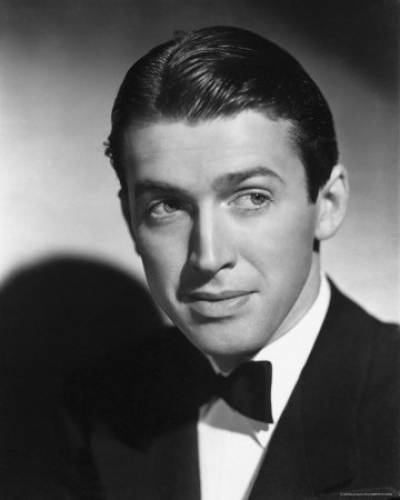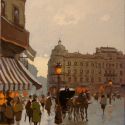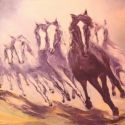
Biography
Life and career
Early life and career
James Maitland Stewart was born on May 20, 1908 to devoutly Presbyterian parents, Alexander and Elizabeth Jackson Stewart, in Indiana, Pennsylvania. The son of a prosperous hardware store owner, he was expected to continue the business, which had been in the family for three generations. The young Stewart was first attracted to aviation, but abandoned dreams of being a pilot to attend Princeton University in 1928. Stewart took quickly to architecture, and was to continue pursuing the field as a graduate student, but he gradually became attracted to the school's drama and music clubs.
His talents led him to be invited to the University Players, a performing arts club comprised of Ivy League musicians and thespians. Taking bit parts in the Players' productions over the summer of 1932, he moved to New York City in the fall, where he shared an apartment with rising actor Henry Fonda and director/playwright Joshua Logan. In November he was cast in his first major stage production, as a chauffeur in the Broadway comedy Goodbye Again, in which he had two lines. The play was a moderate success and brought more substantial stage roles for Stewart, including the 1934 hit, Page Miss Glory, and his first dramatic stage role in Sidney Howard's Yellow Jack.
With several favorably reviewed performances on Broadway, he attracted the interest of MGM, and signed a contract with the company in April of 1935. At first, he had trouble breaking into Hollywood due to his gangly looks and shy, humble screen presence. His first film was the poorly received Spencer Tracy vehicle, The Murder Man, but Rose-Marie, an adaptation of a popular opera, was more successful. After mixed success in film, he received his first substantial part in 1936's After the Thin Man, playing a psychotic killer. Stewart found his footing in Hollywood thanks largely to ex-University Player Margaret Sullavan, who campaigned for Stewart to be her leading man in the 1936 romantic comedy Next Time We Love and rehearsed extensively with him.
Stewart was a lifelong supporter of Scouting. He was a Second Class Scout when he was a youth, an adult Scout leader, and a recipient of the prestigious Silver Buffalo Award from the Boy Scouts of America (BSA). He made advertisements for BSA, which led to him sometimes incorrectly being identified as an Eagle Scout.
Prewar success
Mr. Smith Goes to Washington earned Stewart an Academy Award nomination.
Stewart began a successful partnership with director Frank Capra in 1938, when he was loaned out to Columbia Pictures to star in You Can't Take It With You. The heartwarming Depression-era film, starring matinee idol Jean Arthur, went on to win the 1939 Best Picture Academy Award. 1939 saw Stewart team with Capra and Arthur again for the political comedy-drama, Mr. Smith Goes to Washington. Stewart replaced intended star Gary Cooper in the film about an idealistic man thrown into the political arena. Upon the film's October release, it garnered critical praise and became a box office success. For his performance, Stewart was nominated for the first of five Academy Awards for Best Actor. Destry Rides Again, also released that year, became Stewart's first western film, a genre for which he would become famous later in his career.
1940 saw Stewart and Margaret Sullavan teaming again for two films. The first, the Ernst Lubitsch romantic comedy, The Shop Around the Corner, starred Stewart and Sullavan as co-workers unknowingly involved in a pen-pal romance who cannot stand each other in real life. The Mortal Storm, directed by Frank Borzage, was one of the first blatantly anti-Nazi films to be produced in Hollywood and featured the pair as a husband and wife caught in turmoil upon Hitler's rise to power. He also starred opposite Katherine Hepburn and Cary Grant in George Cukor's classic The Philadelphia Story. His performance as an intrusive, fast-talking reporter earned him his only Academy Award in a competitive category (Best Actor, 1941).
He went on to appear in a series of screwball comedies with varying levels of success. Stewart followed the mediocre No Time for Comedy (1940) and Come Live with Me (1941) with the Judy Garland musical Ziegfeld Girl and the George Marshall romantic comedy Pot o' Gold. Foreseeing war on the horizon, Stewart enlisted in the United States Army Air Corps in March of 1941. Stewart's enlistment coincided with the lapse in his MGM contract and marked a turning point in Stewart's career.
Wartime activity and marriage
Stewart as a colonel
Nearly a year before the December 1941 attack on Pearl Harbor, Stewart was drafted into the United States Army Air Corps, although his enlistment was denied due to a weight restriction. Only five pounds under the minimum limit, he was able to convince the draft board to accept him. He successfully enlisted in the army in March of 1941. Since the United States had yet to declare war on Germany and because of the army's unwillingness to put celebrities on the front, Stewart was held back from combat duty, although he did earn a commission as a 2nd Lieutenant and completed pilot training. He later became an instructor pilot for the B-17 Flying Fortress stationed in Albuquerque, NM.
While petitioning his superiors for combat assignment, Stewart aligned himself with the First Motion Picture Unit and starred and produced a number of training and educational films. Between 1942 and the end of the war, he appeared in nearly a dozen productions, some of which were screened theatrically in civilian theaters.
Col. Stewart being awarded the Croix de guerre with palm by Lt. Gen. Henri Valin, Chief of Staff of the French Air Force, for his role in the liberation of France. USAF photo.
In August 1943 he was finally assigned to the 445th Bombardment Group in Sioux City, Iowa, first as Operations Officer of the 703d Bomb Squadron, and then its commander. In December the 445th BG flew its B-24 Liberator bombers to Tibenham, England and immediately began combat operations. While flying missions over Germany, Stewart was promoted to major. In March, 1944, he was transferred to the 453rd Bomb Group, another new B-24 outfit that had been experiencing difficulties, as Group Operations Officer. In 1944 he twice received the Distinguished Flying Cross for actions in combat, and was awarded the Croix de Guerre. He also received the Air Medal with three oak leaf clusters. In July, 1944, after flying twenty combat missions, Stewart was made Chief of Staff of the 2d Combat Bomb Wing of the Eighth Air Force. Before the war ended he was promoted to colonel, one of only a few Americans to rise from private to colonel in four years.
Stewart continued to play an active role in the United States Air Force Reserves after the war, achieving the rank of Brigadier General on July 23, 1959. His final mission for the Air Force was a B-52 Stratofortress bombing run during the Vietnam War and he retired from the Air Force on May 31, 1968 after twenty-seven years of service. Perhaps due to his dislike of violence, Stewart declined to answer any questions about his combat during World War II and the Vietnam War, though he remained a proponent of the armed forces. At the time of his B-52 mission, he refused the release of any publicity regarding his participation as he did not want it treated as a stunt for glory, but as his job as an officer in the reserves.
After the war, Stewart settled down at age 41, marrying former model Gloria Hatrick McLean on August 9, 1949. They remained devotedly married until her death on February 16, 1964 due to lung cancer. Stewart adopted her two sons, Michael and Ronald, and together they had twin daughters, Judy and Kelly, on May 7, 1951. Ronald McLean was killed in action on June 8, 1969 while serving in Vietnam.
Postwar success
Stewart and Donna Reed in It's a Wonderful Life.
Upon James Stewart's return to Hollywood in the fall of 1945, he decided not to renew his MGM contract. Instead, Stewart signed with an MCA talent agency. The move made Stewart one of the first independently contracted actors and gave him more freedom to choose the roles he wished to play. For the remainder of his career, Stewart was able to work without limits to director and studio availability.
For his first film in five years, Stewart appeared in his third and final Frank Capra production, It's a Wonderful Life. Stewart appeared as George Bailey, a small-town man and upstanding citizen, who becomes increasingly frustrated by his ordinary existence and financial troubles. Driven to suicide on Christmas Eve, he is led to reassess his life by an "angel-in-training," played by Henry Travers. Though the film was nominated for five Academy Awards, including Stewart's third Best Actor nomination, it received only moderate success at the box office, possibly due to its dark nature. However, in the decades since the film's release, it grew to define Stewart's film persona and is widely considered as a sentimental Christmas film classic.
Stewart also returned to the stage for the Mary Chase-penned comedy Harvey, which opened to nearly universal praise in November, 1944. Elwood P. Dowd, the protagonist and Stewart's character, is a wealthy eccentric living with his sister, whose best friend is an invisible rabbit. While trying to have Dowd committed to a sanitorium, his sister is committed herself while the play follows Dowd on an ordinary day in his not-so-ordinary life. James Stewart took over the role from Frank Fay in 1947 and gained an increased Broadway following in the unconventional play. The play, which ran for nearly three years with Stewart as its star, was successfully adapted into a 1950 film, directed by Henry Koster, with Stewart playing Dowd and Josephine Hull as his sister, Veta. For his performance in the film, Stewart received his fourth Best Actor nomination.
After Harvey, the comedic adventure film Malaya and the conventional biographical film The Stratton Story in 1949, Stewart entered what many critics cite as his "golden era" as an actor. During the 1950s, he took on more challenging roles and expanded into the western and suspense genres, thanks largely to collaborations with directors Alfred Hitchcock and Anthony Mann. Other notable performances by Stewart during this time include the critically acclaimed 1950 Delmer Daves western Broken Arrow, which featured Stewart as an ex-soldier making peace with the Apache; a troubled clown in the 1952 Best Picture The Greatest Show on Earth; and Stewart's role as Charles Lindbergh in Billy Wilder's 1957 film The Spirit of St. Louis.
Collaborations with Hitchcock and Mann
James Stewart's collaborations with director Anthony Mann expanded Stewart's popularity and expanded his career into the realm of the western. Stewart's first appearance in a film helmed by Mann came with the 1950 western classic, Winchester '73. The film, which became a massive box office hit upon its release, set the pattern for their future collaborations. Other Stewart-Mann westerns, such as Bend of the River (1952), The Naked Spur (1953), The Far Country (1954), and The Man from Laramie (1955) were perennial favorites among young audiences entranced by the American west. Frequently, the films featured Stewart as a troubled cowboy seeking redemption, while facing corrupt cattlemen, ranchers, and outlaws. Their collaborations laid the foundation for many of the westerns of the 1950s and remain popular today.
Stewart and Mann also collaborated on other films outside the western genre. 1953's The Glenn Miller Story was critically acclaimed, garnering Stewart a BAFTA Award nomination, and (together with The Spirit of St. Louis) cemented the popularity of Stewart's portrayals of "American heroes." Thunder Bay, released the same year, transplanted the plot arch of their western collaborations in the present day, with Stewart as a Louisiana oil-driller facing corruption. Strategic Air Command, released in 1955 allowed Stewart to utilize his experiences in the United States Air Force on film.
Stewart and Kim Novak in Vertigo.
The second collaboration to define Stewart's career in the 1950s was with acclaimed mystery and suspense director Alfred Hitchcock. Stewart had previously appeared in Hitchcock's technologically innovative 1948 film Rope', and the two collaborated for the second of four times on the 1954 hit Rear Window. Photographer L.B. "Jeff" Jeffries, the central character of the film, portrayed by Stewart, projects his fantasies and fears onto the people he observes out his apartment window while on hiatus due to a broken leg. Jeffries gets into more than he can handle, however, when he believes he has witnessed a salesman murder his wife.
After starring in Hitchcock's remake of the director's own production, The Man Who Knew Too Much, Stewart starred in what many consider Hitchcock's most personal film, Vertigo. The film starred Stewart as Scottie, a former police investigator suffering from acrophobia, who develops an obsession of a woman he is shadowing. Scottie's obsession inevitably leads to the destruction of everything he once had and believed in. Though the film is widely considered a classic today, it was met with negative reviews and poor box office receipts upon its release, and marked the last collaboration between Stewart and Hitchcock.
Career in the '60s and '70s
In 1960, James Stewart was awarded the New York Film Critics Circle Award for Best Actor and nominated for his fifth and final Academy Award for Best Actor for his role in the 1959 Otto Preminger film Anatomy of a Murder. The early courtroom drama starred Stewart as Paul Biegler, the lawyer of a man who claims temporary insanity after murdering the man who raped his wife. Stewart's nomination was one of seven for the film, and saw his transition into the final decades of his career.
The early sixties saw Stewart taking lead roles in three John Ford films. The first, 1962's The Man Who Shot Liberty Valance (with John Wayne) became a classic western and featured Stewart as an attorney who goes against his principles when he is forced to shoot an outlaw (played by Lee Marvin). Stewart's character is compelled to face his past as he attempts to build a career in politics. How the West Was Won and Cheyenne Autumn, were western epics released in 1962 and 1964 respectively. While the Cinerama production Western went on to win three Oscars and reaped massive box office figures, Cheyenne Autumn, in which a white-suited Stewart played Wyatt Earp in a long sequence in the middle of the movie, failed domestically and was widely forgotten.
Stewart in Mr. Hobbs Takes a Vacation.
Having played his last romantic lead in 1958's Bell Book and Candle, Stewart transitioned into more family-related films in the 1960s. These included the successful Henry Koster outing Mr. Hobbs Takes a Vacation (1962), and the less memorable films Take Her, She's Mine (1963) and Dear Brigitte (1965), which featured French model Brigitte Bardot. The Civil War period film Shenandoah (1965) and the western family film The Rare Breed faired better at the box office.
Jimmy Stewart and His Poems (1989)
After a progression of lesser western films in the late sixties and early seventies, James Stewart transitioned from cinema to television. He first starred in the NBC comedy The Jimmy Stewart Show, which featured Stewart as a college professor. He followed it with the CBS mystery Hawkins, in which he played a small town lawyer investigating his cases. The series garnered Stewart a Golden Globe for Best Actor in a Dramatic TV Series, but failed to gain a wide audience and was cancelled after one season. During this time, Stewart periodically appeared on Johnny Carson's The Tonight Show, sharing poems he had written at different times in his life. His poems were later successfully compiled into a short anthology titled Jimmy Stewart and His Poems (1989).
Stewart finished the decade with supporting roles in John Wayne's final film, The Shootist, Airport '77, the 1978 remake of The Big Sleep, and The Magic of Lassie (1978).
Later career and death
Stewart's last film, An American Tail: Fievel Goes West.
After filming several television movies in the 1980s, including the popular Mr. Krueger's Christmas, James Stewart retired from acting to spend time with his family. He returned only to voice Sheriff Wylie Burp in the successful 1991 animated film An American Tail: Fievel Goes West.
Stewart died on July 2, 1997 of a pulmonary embolism, just one day after fellow screen veteran and The Big Sleep co-star Robert Mitchum died. He is interred in Forest Lawn Memorial Park Cemetery in Glendale, California.
Jimmy Stewart has a star on the Hollywood Walk of Fame at 1708 Vine Street. In 1972, he was inducted into the Western Performers Hall of Fame at the National Cowboy & Western Heritage Museum in Oklahoma City, Oklahoma. He was awarded various lifetime achievement awards from the Academy Awards (1985), American Film Institute (1980), Lincoln Center (1990), Golden Globe Awards (1965), National Board of Review (1990), and the Screen Actors Guild (1969).
A statue of Stewart was erected on the lawn of the Indiana County Courthouse in his hometown, Indiana, Pennsylvania, on May 20, 1983 to celebrate Stewart's 75th birthday. In 1995, a museum dedicated to his life and career, The Jimmy Stewart Museum, opened as well.
Filmography
For a detailed filmography, see: James Stewart Filmography
From the beginning of James Stewart's career in 1935 through his final theatrical project in 1991, Stewart appeared in ninety-two films, television programs, and shorts. Through the course of his career, he appeared in many landmark and critically acclaimed films, including such classics as Mr. Smith Goes to Washington and Vertigo. His roles in ...Washington, The Philadelphia Story, It's a Wonderful Life, Harvey, and Anatomy of a Murder earned him Academy Award nominations (he won for Philadelphia). Stewart's career defied the boundaries of genre and trend, and he made his mark in screwball comedies, suspense thrillers, westerns, and family films.
Broadway stage performances
Carry Nation (Oct. 1932–Nov. 1932)
Goodbye Again (Dec. 1932–Jul 1933)
Spring in Autumn (Oct. 1933–Nov. 1933)
All Good Americans (Dec. 1933–Jan. 1934)
Yellow Jack (May 1934)
Divided By Three (Oct. 1934)
Page Miss Glory (Nov. 1934–Mar. 1935)
A Journey By Night (Apr. 1935)
Harvey (Nov. 1944–Jan. 1949)
Harvey (revival, Feb. 1970–May 1970)
Awards
1985 - Honorary Award - Lifetime Achievement
1941 - Best Actor - The Philadelphia Story
Nominated:
1960 - Best Actor - Anatomy of a Murder
1951 - Best Actor - Harvey
1947 - Best Actor - It's a Wonderful Life
1940 - Best Actor - Mr. Smith Goes to Washington
BAFTA Awards
Nominated:
1960 - Best Foreign Actor - Anatomy of a Murder
1955 - Best Foreign Actor - The Glenn Miller Story
Golden Globes Won:
1974 - Best TV Actor - Drama - Hawkins
1965 - Cecil B. DeMille Award - Lifetime Achievement
Nominated:
1951 - Best Motion Picture Actor - Drama Harvey
See also
Notable figures in Western films
List of film collaborations
References
Collins, Jr., Thomas W. (2000). "Stewart, James"
International Dictionary of Films and Filmmakers, edition 4 (2000). Article: Stewart, James
St. James Encyclopedia of Popular Culture, edition 5 (2000). Article: Stewart, James
"The Jimmy Stewart Museum Home Page". Retrieved Dec 26, 2005
"Wright Patterson Air Force Base". Retrived Dec 26, 2005

































